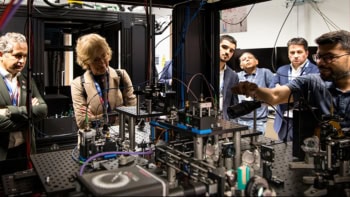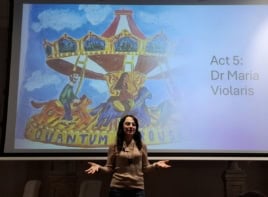
Ions trapped nanoscale optical cavities could be used to distribute entangled quantum particles over large distances. That is the conclusion of Jonathan Kindem and colleagues at Caltech in the US, who showed that a trapped ion of ytterbium can remain entangled with a photon for long periods of time. Furthermore, the team showed that the ion’s quantum state can be read out when manipulated by laser and microwave pulses. Their achievement could lay the foundations for a future quantum internet.
Quantum computers are becoming a reality as research labs and companies roll out nascent devices. An important next step in this quantum revolution is creating a “quantum internet” across which quantum information can be shared. The delicate nature of quantum information, however, means that it is very difficult to connect quantum computers over long distances.
Most quantum computers encode quantum bits (qubits) of information into the quantum states of matter – trapped atoms or superconducting circuits, for example. However, the best way to transmit quantum information over long distances is to encode it into a photon of light. An important challenge is how to transfer quantum information from stationary matter-based qubits to photon-based “flying” qubits and then back again.
Attractive properties
Qubits made from solid materials interact strongly with light and therefore readily transfer quantum information to photons. However, these qubits tend to be very short-lived, which makes it difficult to use them to build practical quantum computers. Trapped atoms or ions, on the other hand, can make long-lived qubits but interact weakly with light. Rare-earth ions have properties that could make them particularly long-lived qubits, but physicists have struggled to trap them in such a way that they can be controlled and interact with light.
In their study, Kindem’s team showed that this problem could be overcome by placing a rare-earth ion of ytterbium in an optical cavity to enhance its interaction with light. To do this, they fabricated a periodic, nano-patterned 10 micron-long cavity with the ion at its centre. Light bounces back and forth many times in the cavity, greatly increasing the chance of the light interacting with the ion.
The researchers then manipulated their ion qubit using laser and microwave pulses. The result is the emission of a photon that is entangled with the qubit – a photon that itself is a flying qubit of quantum information.

Quantum-computer node uses two different ion species
More than 99% of the time, they found that this entangled photon remained inside the cavity, bouncing back and forth. This allowed the team to study the photon-ion system over a relatively long time period. Indeed, Kindem and colleagues observed that the photon and ion can remain entangled for up to 30 ms – long enough for the photon to travel across the continental US.
Kindem’s team now hopes to scale up their experiment to enable information exchange between two real, distant qubits — demonstrating the building blocks of a realistic quantum internet. Within such a network, quantum computers in widely spaced geographical locations could share data and perform calculations together; potentially allowing extremely large computations to take place. It could also enhance the prospects for quantum cryptography by allowing networks of trusted parties to exchange information securely using entangled particles.
The research is described in Nature.



